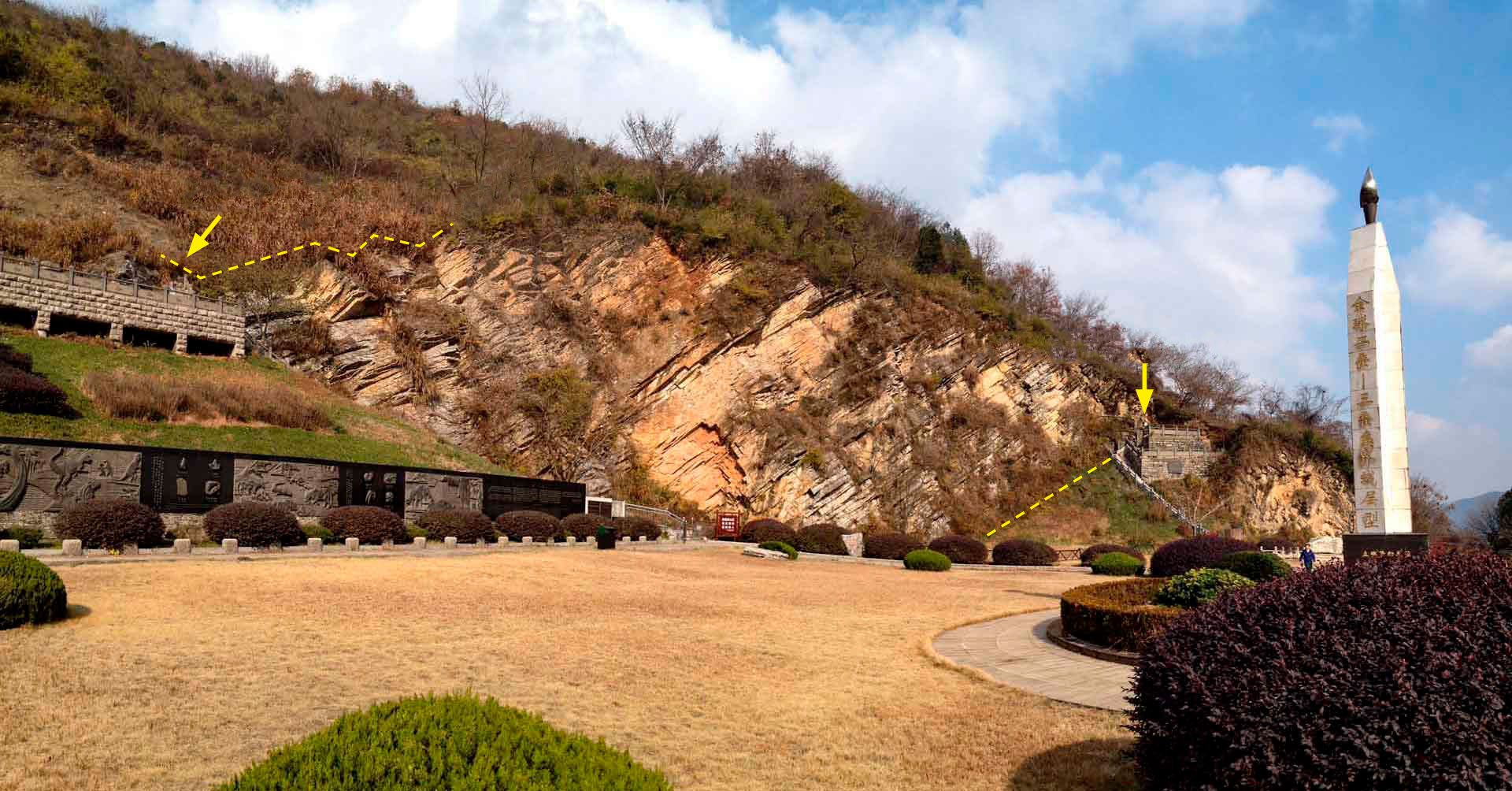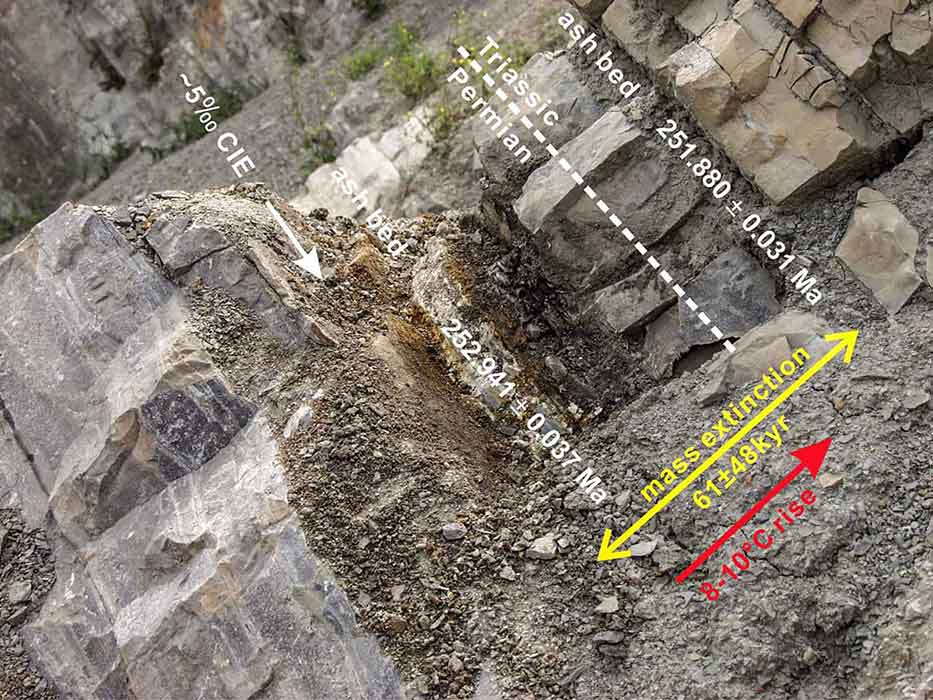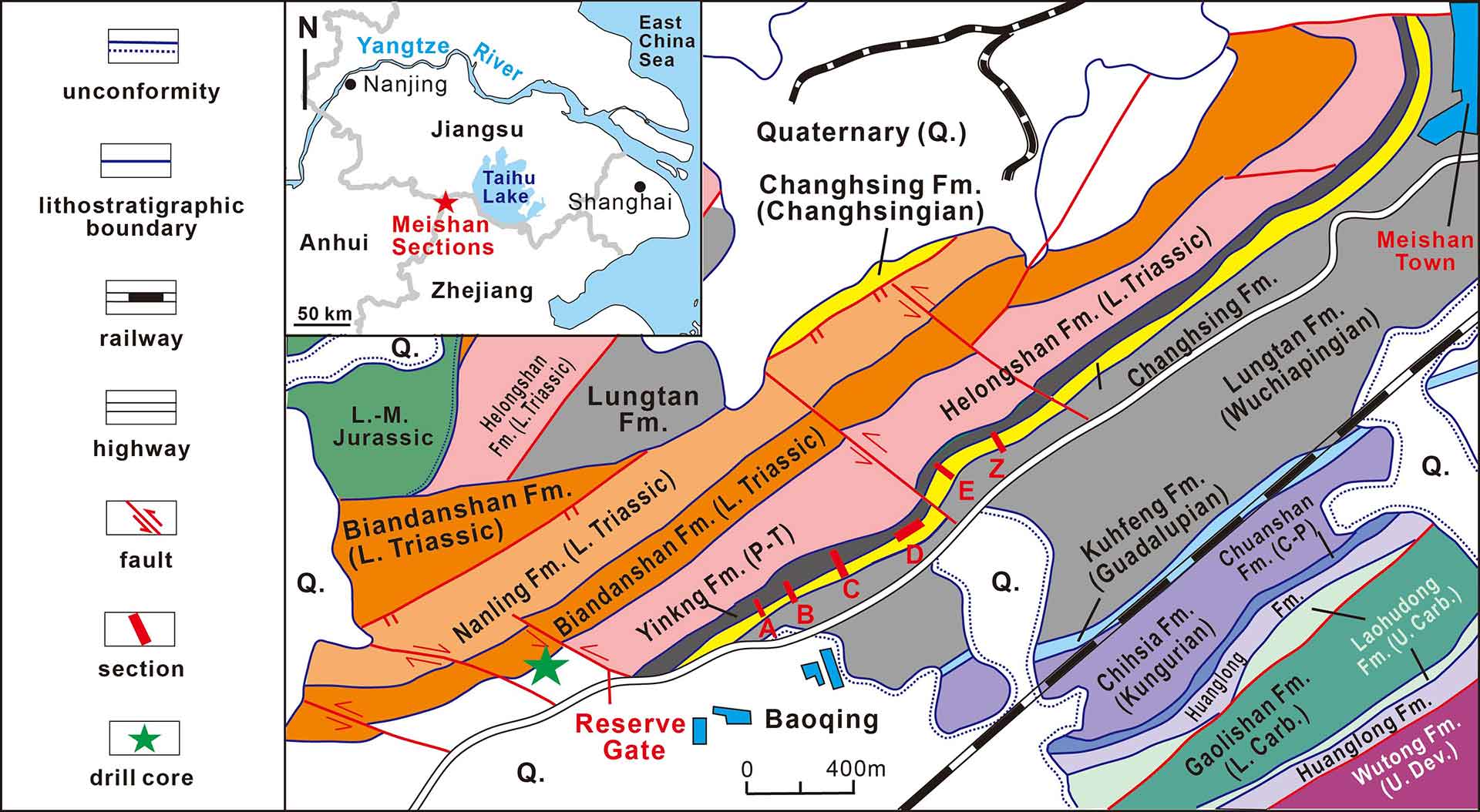
Photograph showing the Changhsingian Stage defined between Induan GSSP (left arrow) and Changhsingian GSSP (right arrow). This section has been intensively-studied containing several highprecision geochronology and lithostratigraphy points.
Geological Period
Permian – Triassic
Main geological interest
Stratigraphy and sedimentology
Paleontology
Location
Changxing County, Zhejiang Province, southeast China.
31°04’51.0″N, 119°42’22.0″E
Photograph showing the Changhsingian Stage defined between Induan GSSP (left arrow) and Changhsingian GSSP (right arrow). This section has been intensively-studied containing several highprecision geochronology and lithostratigraphy points.
One of the most detailed and documented records of the greatest Phanerozoic mass extinction.
The Meishan D section is a unique section in containing two GSSPs including the base of the Triassic (thus the base of Mesozoic) (Yin et al., 2001) and the base of the Changhsingian Stage (Jin et al., 2006). High-precision geochronology from multiple ash beds has provided a precise calibration for Earth’s biggest mass extinction as well as rates of biodiversity, geochemical and paleoclimatic changes. The ash beds of the Meishan sections have been used as a natural laboratory for refining high-precision geochronologic dating, since the results of Bowring et al., (1998). Magnetic polarity zones and astronomical cycles are also used for inter-continental correlation between marine and terrestrial successions around the Permian-Triassic boundary.
- Geological description
These Meishan GSSP sections are the most intensively-studied Lopingian (Upper Permian) and Permian-Triassic boundary sections in the world. The Permian strata contain a highly diverse tropical marine fauna, which includes more than 330 species belonging to 15 different fossil groups (Jin et al., 2000). These sections possess the best record of the end-Permian mass extinction that occurred 251.94 million years ago when more than 81% (formerly ~96%) marine species became extinct within a time interval <61±48 kyr (Burgess et al., 2014). Multiple geochemical records including C, O, Sr, S, Li, Zn, Hg and Ca isotopes have provided proxies for environmental deterioration leading to the extinction. These include a rapid 10°C temperature rise, euxinia and ocean acidification. The sections are correlated using high-resolution conodont and ammonoid biostratigraphic zones and geochronology. More than 30 volcanic ash beds have yielded eight high-precision CA-ID-TIMS dates. Detailed magnetostratigraphy and astronomical cyclostratigraphy also aid correlation. For many decades, the Meishan sections have been widely recognized as the premier location for world-wide correlation of the Permian-Triassic boundary (Yin et al., 2001) and for understanding the biggest Phanerozoic biotic mass extinction (Jin et al., 2000; Shen et al., 2011).
- Scientific research and tradition
The Meishan sections include excellent quarry exposures of the Permian-Triassic boundary and the entire Changhsingian Stage, and the reserve covers an area of 2.3 km2. More than 200 articles and books were published including 11 in Science and Nature since Grabau first mentioned the site in 1932. The sections have been protected since 1981, and the site was named as the National Geoheritage Reserve of China in 2005.
- Reference
Bowring, S.A. et al. (1998) ‘U/Pb zircon geochronology and tempo of the end-permian mass extinction’, Science, 280(5366), pp. 1039–1045. Available at: https://doi.org/10.1126/science.280.5366.1039.
Burgess, S.D., Bowring, S. and Shen, S. (2014) ‘High-precision timeline for Earth’s most severe extinction’, Proceedings of the National Academy of Sciences, 111(9), pp. 3316–3321. Available at: https://doi.org/10.1073/pnas.1317692111.
Jin, Y. et al. (2006) ‘The Global Boundary Stratotype Section and Point (GSSP) for the base of Changhsingian Stage (Upper Permian)’, Episodes, 29(3), pp. 175–182. Available at: https://doi.org/10.18814/epiiugs/2006/v29i3/003.
Jin, Y.G. et al. (2000) ‘Pattern of marine mass extinction near the Permian-Triassic boundary in South China’, Science, 289(5478), pp. 432–436. Available at: https://doi.org/10.1126/science.289.5478.432.
Shen, S.Z. et al. (2011) ‘Calibrating the end-Permian mass extinction’, Science, 334(6061), pp. 1367–1372. Available at:https://doi.org/10.1126/science.1213454.
Yin, H. et al. (2001) ‘The Global Stratotype Section and Point (GSSP) of the Permian-Triassic boundary’, Episodes, 24(4), pp. 102–114. Available at: https://doi.org/10.18814/EPIIUGS/2001/V24I2/004.
- Author(s)
Shuzhong Shen
School of Earth Sciences and Engineering, Nanjing University, Nanjing, China


